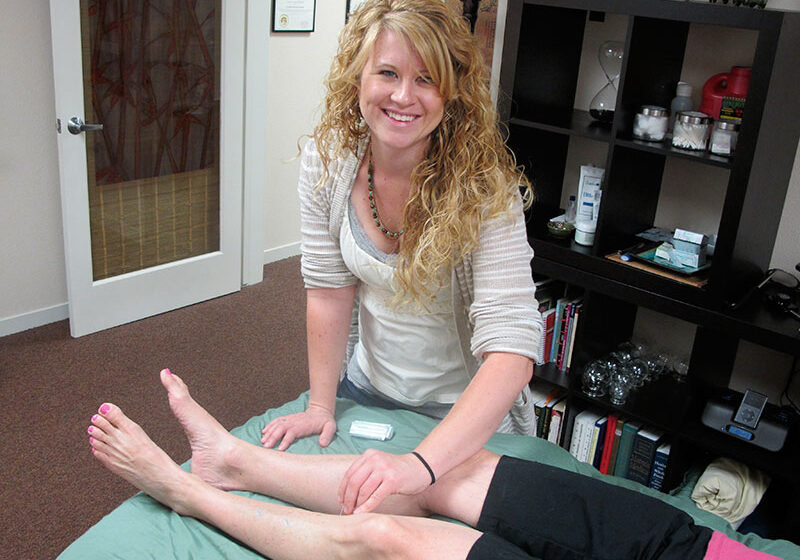The dinner scene is dishearteningly familiar. Your 8-year-old daughter takes a couple bites of spaghetti, then starts poking at the food on her plate. “Eat up!” you say brightly, hoping her response will be different this time.
“I’m full,” she says, rubbing her belly. “I don’t feel very good.”
Almost nothing is more concerning than a child who won’t eat. Sure, all kids get stomach aches. But when gastrointestinal distress – cramps, diarrhea, nausea – frequently interrupts your child’s daily activities, your own gut begins to say: “Something’s wrong.”
 Diagnoses of chronic conditions, such as irritable bowel syndrome (IBS), gastroesophageal reflux disease (GERD), inflammatory bowel disease (IBD), and celiac disease, are becoming more common in the pediatric population. Food intolerance may occur either as an isolated condition, or in conjunction with another condition, exacerbating its symptoms.
Diagnoses of chronic conditions, such as irritable bowel syndrome (IBS), gastroesophageal reflux disease (GERD), inflammatory bowel disease (IBD), and celiac disease, are becoming more common in the pediatric population. Food intolerance may occur either as an isolated condition, or in conjunction with another condition, exacerbating its symptoms.
Coming up with a definitive diagnosis and an effective treatment plan for these kids often takes time, and requires good teamwork. Pediatricians typically refer patients to a gastroenterologist when symptoms are frequent, don’t resolve over a few months, or begin to affect a child’s health or quality of life. Dr. Bruce Birk says, “A GI specialist is a consultant who can help me develop a plan of care for my patients. The most common referrals I make are for constipation, abdominal pain, chronic diarrhea, chronic vomiting, severe gastroesophageal reflux, and failure to thrive.”
The treatment plan often includes a specialized diet. Licensed dietitian Lucy Glaize says families come to her with some basic information, but adds, “The fine details can be unexpected and overwhelming.” There may be cross-contamination issues or sources of hidden problem foods that parents haven’t thought about.
Diagnosed with celiac disease when she was ten, Glaize has firsthand knowledge of what her patients experience. She helps families make changes one step at a time. “We can break the process down so it’s less overwhelming,” she says. She adds that it’s important for parents to discuss the child’s needs openly and honestly with siblings, friends, and school personnel. As Glaize remarks, “A child should feel confident in her own skin and not embarrassed or shy about having specialized dietary needs.”
It is estimated that more than 40 percent of people with chronic digestive conditions seek treatment through complementary and alternative medicine. Dr. Patrick Giammarise, DC, is practitioner and owner of the Digestion Relief Center in Chico, and co-treats many patients who see other specialists. He says his hands-on nutrition based treatment methods differ from traditional Western medicine, in that he focuses on improving function rather than on the pathology. “For most people with digestive disorders, including kids, it’s either a functional problem or a food sensitivity, rather than a structural issue or disease.” By desensitizing the digestive tract to problem foods and/or using specific enzymes to aid digestion, Giammarise says patients with food sensitivities and functional bowel disorders often find they can eat more foods. Many are also able to decrease the number of medications they take, thus reducing side effects.
Effective management of any chronic gastrointestinal condition is a long-term effort, but critical. Left untreated, many of these conditions have serious long-term physical health consequences – and all impact social-emotional wellbeing. Read on for more details about some common chronic gut disorders.
GERD – Gastroesophageal Reflux Disease
Reflux is the movement of gastric (stomach) contents back into the esophagus. It is common in infants, but usually resolves by 18 months without intervention. In older children with GERD, the sphincter between the esophagus and stomach malfunctions. Stomach acid constantly enters the esophagus, and can damage the lining. Over time, other areas – pharynx, larynx, lungs, sinuses, ears, teeth – may be affected.
Symptoms: Heartburn (reported by kids as stomach ache or chest discomfort, especially after meals); wet burps or vomiting; poor appetite; swallowing difficulties; sore throat or hoarseness; respiratory difficulties (apnea, wheezing, chronic cough or throat clearing); chronic ear or sinus infections; weight loss; irritability; tooth decay.
Kids affected: GERD symptoms are experienced by up to 25 percent of children and teens.
Resource: Association of Gastrointestinal Motility Disorders, http://www.agmd-gimotility.org.
IBS – Irritable Bowel Syndrome
Gastrointestinal symptoms are caused by a disturbance of movement through the intestine. Symptoms of this functional condition may be frequent, but the GI tract is not damaged. Stress and certain foods are thought to be triggers.
Symptoms: Abdominal discomfort; cramping; chronic diarrhea and/or constipation; bloating; urgency with defecation; decreased appetite.
Kids affected: It is estimated that 5 to 15 percent of kids have IBS.
Resource: International Foundation for Functional Gastrointestinal Disorders, http://www.aboutibs.org.
Celiac Disease
The immune system reacts to gluten (a protein found in all products containing wheat, barley and rye) as a pathogen. Intestinal villi are damaged, resulting in an inability to absorb nutrients properly. People with celiac are more prone to other autoimmune disorders, as well as thyroid disease, osteoporosis, and skin problems. A lifelong 100% gluten-free diet is the only effective treatment.
Symptoms: Weight loss; nausea; abdominal pain; diarrhea; constipation; vomiting; bloating; failure to thrive.
Kids affected: About one percent of children and adults have celiac. Kids with affected family members are more at risk. In addition, about eight percent of people are gluten sensitive, though they do not suffer intestinal damage and can eat small amounts of gluten.
Resource: Gluten Intolerance Group, http://www.gluten.org.
Crohn’s Disease
Crohn’s is one of several Inflammatory Bowel Diseases (IBDs). The immune system targets “good” gut bacteria, causing inflammation. Any part of the digestive tract can be affected, from mouth to anus. Causes are not well understood. Stress and diet may exacerbate Crohn’s. Kids with family members who have Crohn’s are more at risk.
Symptoms: Abdominal pain; cramping; bloody stool; diarrhea; constipation; fever; ulcerations.
Kids affected: Of 700,000 diagnosed cases of Crohn’s, about 20 percent are in children. Adolescents and young adults, ages 15-35, are most commonly diagnosed.
Resource: Crohn’s and Colitis Foundation of America, http://www.ccfa.org.
Food Intolerance
A food intolerance results when the body is unable to digest the offending food – e.g., a key enzyme is not being produced (as in lactose intolerance), or there is a functional issue in the digestive tract.
Symptoms: Abdominal pain; bloating; diarrhea; constipation; reflux; chronic ear infections; runny nose; fatigue; irritability; hyperactivity (in children). In contrast to a food allergy (an almost immediate and potentially fatal immune system reaction to a food, usually involving multiple body systems), symptoms of a food intolerance are less severe and often don’t show up for hours, or even days after ingesting the offending food. A person with a food intolerance can often eat small amounts of the food without consequence, whereas a person with an allergy must avoid even skin contact with the food.
Kids affected: It’s estimated that between five and seven percent of kids have a food allergy, and the incidence is increasing. Many more children suffer with food intolerances.
Resource: The book Understanding Your Food Allergies and Intolerances: A Guide to Management and Treatment, by Wayne Shreffler.
Questions to ask the doctor about medications and procedures:
- What are the long-term and short-term side effects of this medication on children?
- How long has this medication been used to treat children?
- Why do you want to perform this procedure (barium swallow, scan, colonoscopy, etc.), and what should we expect to learn from the results?
- Are there non-pharmacological, non-surgical options available?
- Could you provide some information/resources to help with our decision? (Links to recent research, FAQs, kid-friendly videos of procedure, support groups, etc.)
More information:
- Digestion Relief Center, Chico, CA, http://www.digestionreliefcenter.com; (530) 899-8741.
- GI Kids, http://www.gikids.org.
- Kids Health, http://www.kidshealth.org.
Books:
- Food Diary for IBS: Keep Track of Food and Symptoms Diary, by Frances P. Robinson
- Hope is Certain: A Story of a Teenager with Crohn’s, by Krystal Welk
- The Reflux Book: A Parent’s Guide to Gastroesophageal Reflux, by Beth Pulsifer-Anderson
- Willie Villie Meets Casey Kramps in Sprueville: A Book About Celiac Disease, by Elena Torsiello
Posted in: Health & Nutrition
Comment Policy: All viewpoints are welcome, but comments should remain relevant. Personal attacks, profanity, and aggressive behavior are not allowed. No spam, advertising, or promoting of products/services. Please, only use your real name and limit the amount of links submitted in your comment.
You Might Also Like...

On Pins And Needles – The Benefits Of Acupuncture
For a woman who admits being extremely afraid of needles, Patti Furnari is a huge fan of acupuncture. Having dealt with the debilitating pain of migraines for over 25 years, […]

Surviving and Thriving on a Single Income
Life is expensive. Life with kids is even more expensive. According to Pew Research, 31 percent of families live on a single income. Although many families make the choice, others […]
Skin Care Tips for Busy Moms
Every woman blessed with the opportunity to be a mother faces the challenge of balancing her own needs with the needs of her child or children. My children are grown […]

Choosing the Best Exercise for Your Unique Pelvic Floor
I was approached by North State Parent Magazine regarding writing an informative piece about the pelvic floor. After 25 years working as a physical therapist in the field of pelvic […]



